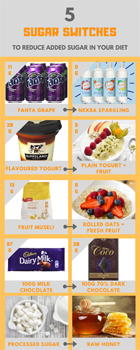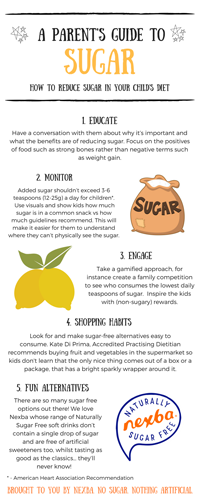5 Tips to Reduce Sugar in Your Child's Diet

Don't Sugar-Coat It!
With childhood obesity and diabetes a growing concern, parents today want their kids' horizons, not waistlines, to expand but health trends show the opposite. According to the Australian Institute of Health and Welfare (AIHW), about 1 in 4 (27%) of children and adolescents aged 5-17 are overweight or obese – that equates to more than 1 million children and young Australians are overweight or obese.
The risks of obesity are both physical and emotional according to the Victorian Department of Education and Training. Short-term impacts can include: high blood fat levels, increased blood pressure, insulin resistance, impaired glucose tolerance, decreased self-esteem and quality of life; and even marginalisation. Long-term effects can include diabetes, coronary heart disease, stroke, osteoarthritis, high blood pressure, non-alcoholic fatty liver disease, some cancers, infertility; and social and employment problems.
The consumption of sugary drinks has been a major contributor to the obesity epidemic. Sugary drink portion sizes have risen dramatically over the past 40 years, and children and adults are drinking more soft drinks than ever before.
The good news is that taking preventative measures can counter both emotional and physical impacts in children.
 Here are five tips for happy and healthy eating!
Here are five tips for happy and healthy eating!
Teach, don't preach
Whilst we may know sugar is bad, kids don't always understand the reason why we should make choices about what we eat. Have a conversation with them about why it's important and what the benefits are of reducing sugar. Focus on the positives of food such as strong bones rather than negative terms such as weight gain. They will often be learning about similar topics in school, so they can relate back to their own learnings.
Beware that sugar isn't always labelled as "sugar"! SugarScience, an authority about sugar and its impact on health, says there are actually 61 names for sugar. These include common names, such as sucrose and high-fructose corn syrup, as well as barley malt, dextrose, maltose and rice syrup, among others.
Monitor and measure
Watch out for these "convenient" drinks and snacks that tip the balance on sugar content. The American Heart Association suggests added sugar shouldn't exceed 6 teaspoons (25g) for women, 9 teaspoons (38g) for men, and 3-6 teaspoons (12-25g) for children. One way to help explain this to kids is to visually represent the sugar – show them how much sugar is in a common snack vs how much guidelines recommend. This will make it easier for kids to understand sugar in products where they can't physically see it.
Some common products to look out for:
Fanta Grape has one of the highest amounts of sugar in a soft drink: 12.4g per 100ml. There are 11 teaspoons (or 44g) of sugar in a 355ml can
Sauces are easy to brush over but did you know Masterfoods Barbecue Sauce has 54g of sugars per 100g?
Muesli bars seem like an ideal lunchbox choice but choose carefully: Carman's Dark Choc Cherry & Coconut Bars have 8.2g of sugars per 35g bar (23.5g per 100g)
Yoghurt is healthy . . . or is it? Unflavoured yoghurt is best with flavoured options like Gippsland Dairy's Toffee and Honeycomb Twist Yoghurt containing 28.4g of sugars per 160g individual tub
If Coco Pops weren't high enough in sugar (36.5g of sugars per 100g), Coco Pops Chex Cookies & Cream have 38.6g of sugars per 100g
The LiveLighter public health education campaign calculated that 7-Eleven's mega-size Slurpee Cola has 20.4 teaspoons of sugar in a 1182ml serve
Cancer Council Victoria warned about the sugar content in flavoured milk – Ice Break 750ml Iced Coffee topped the list with 9 teaspoons of added sugar per bottle
Help them keep a food diary – tracking what we consume is important to help us understand and believe the impact of sugar. Set up a simple system for recording daily consumption – keep it on the fridge or use an app that they can relate to. We suggest That Sugar App and Healthy Eats, which are both kid-friendly and can be found on the app store.
Take a gamified approach, for instance create a family competition to see who can get to zero sugar first or who consumes the lowest daily teaspoons of sugar. Extend the challenge to their friends and include (non-sugary) rewards. Knowing their friends are involved can help young people feel less "targeted" by a parental conversation.
Cultivate fun shopping Habits
Look for and make sugar-free alternatives easy to consume. Having poor choices out of reach and good alternatives in plentiful supply can truly help.
Kate Di Prima, Accredited Practising Dietitian and Spokesperson for the Dietitians Association of Australia, recommends buying fruit and vegetables in the supermarket when shopping for kids' snacks, "That's going to be way better than a packaged thing where they learn the only nice thing comes out of a box or a package, that has a bright sparkly wrapper around it." Kate also suggests avoiding foods with sugar as a #1 top ingredient, it should be outside the top three ingredients.
Create fun alternatives
Choose simple, yet fun ways – you can make sugar free ice-blocks with Nexba products. Nexba Beverages are great for kids who aren't that keen on drinking water. Their range of Naturally Sugar Free soft drinks don't contain a single drop of sugar and are free of artificial sweeteners too, whilst tasting as good as the classics … they'll never know!
Quick Tip! Add mint, cucumber, berries or slices of lemon or lime, to water and naturally sugar-free drinks for added natural flavour, colour and fun!
Share your ideas with the Nexba team as we're always interested in community initiatives.
MORE




